By: George E. Warren Jr. Edited by Jacob E. Warren
Date: 1999-11-05
What is a HMD?
HMD is an acronym for Head Mounted Display, which is a set of goggles or a helmet with tiny monitors in front of each eye that generates images seen by the wearer as being three dimensional. A true HMD includes a device for tracking the users head movements and orientation. In other words, it tracks what direction the user is looking. Most HMDs will track yaw, roll, and pitch and some will even track the users head translations, a full six degrees of freedom (6 DOF).
Many HMDs also have 3D sound headsets as part of the unit. Unconstrained objects have six different directions or rotations they are able to move within including forward or backwards, up or down, and left or right; these are called translations. Objects can also rotate around the principal axes, which is roll, yaw, and pitch.
How will HMDs add to fighter simulations?
Mankind is an intensely visual being. The greatest part of situational awareness comes from visual images that are interpreted by the most efficient image processing computer, our brain.
Head Mounted Displays are a technology that allows you to be placed through the computer monitor into the simulation's 3-D world. With an HMD you would have the ability to look and move around in the computer 3-D simulated word as if you were actually sitting in the real aircraft, greatly increasing your situational awareness.
Imagine how this would greatly increase your effectiveness in a combat flight simulation. Instead of looking for and hitting the tracking key or joystick button to padlock onto a bandit or incoming missile you will be able to quickly glance at the target and then look forward again instinctively without even thinking about it, allowing more time and increased concentration to come up with a solution.
With full head tracking the user could free up several buttons on the HOTAS (hands on throttle and stick) system that are used for the different view controls and use them for other functions, thus giving the combat flight simulation pilot more control over his aircraft and weapons systems with a faster reaction time. Furthermore, the general immersiveness is increased.

What is needed from an HMD for fighter simulations?
This can be quite subjective and every computer simulation fighter pilot is going to have their own preferences and minimums. Realizing that for any HMD to give the best performance the software is going to have to support it, let's take a look at this subject.
Minimum resolution of the display has to be at least 800 x 600, a display that is clear and sharp so that the user will not have eye fatigue after a couple hours of use. Field of view (FOV) should be at least be 60 degrees horizontally, and of course the wider the better.
With a wider FOV comes greater situational awareness. Ideally we need very fast tracking of the pilot's head in yaw, pitch and roll and of course 6 DOF would be even better.
3D sound would be great, and a built in microphone so programs such as Game Commander can be used. The unit must be light in weight so as not to wear out the user, but durable enough to last under some real head banging :).
Last but certainly not least, it must be affordable enough for the average die hard P/C combat flight simulation pilot, probably not much more than a good 21" monitor. This means the price point must be between 900 and 1,500 US dollars at the most. Of course the lower the prices, the more sales.
Why is there not a HMD for the home entertainment market?
I sent an email to some of the present day HMD manufactures asking for some information on this subject: Some of the questions were: "Why is there not a HMD for the home entertainment or P/C flight simulation markets? Is it Cost? If so, what component(s) and any reasons why?
Is liability an issue? Is it believed there is not enough of a mass market? The responses that I received where very informative and actually more than I expected. Below are some of the replies that were received in response to these questions.
Paul Travers of Interactive Imaging Systems;
"The HMDs of the past used very expensive displays primarily sourced from Japan. The next generation of IPDs (note; IIS term for HMD) to be successful, will need to be based on a much less expensive display. These new displays are on the horizon from many US based companies. Of course, the displays are only a part of the cost problem. Electronics integration and packaging also will determine cost. The winners in this market will need to address all of these issues.
"On the product liability issue, IIS has shipped over 14,000 IPDs with not a single product liability problem. To be safe, there are some rules that need to be followed and good design is required to make the display system comfortable and non-straining for the user. If it is a strain for the user, they simply will not be able to use the product for any length of time, much like a poor fitting pair of swim goggles.
"To some degree, we believe that this issue has been blow out of proportion (probably because it is a (potential) problem area that receives attention by the media. Finally, there are three very large Japanese companies presently shipping HMDs. In order for them to be doing this they must also feel comfortable about the product liability issue.
"As for market size, the IPD is going to be part of everyday life. Applications will reach a point to where they will be unable to be used without one (much like the mouse is today.) At that point in time it is conceivable that every PC and home entertainment system will have at least one."
Kiera Reilly
Marketing Operations Manager of n-vision®
In a phone conversation Kiera stated that some of the reasons for the high cost of HMDs are the optics, especially for the wide field of view units, and the electronics. She does not believe that motion sickness is much of an issue, as n-vision has not encountered any real problems with this. N-vision dose not have the resources to mass produce HMD for a consumer market, and Kiera stated that the consumer is not going to be happy with an HMD purchase unless the visual quality is equal to what he or she will see on their computer monitor.
She also feels that the consumer is going to expect a fairly wide field of view. While HMDs with such performance are available from n-vision, they are simply too expensive to produce at a price the consumer market can even begin to accept.
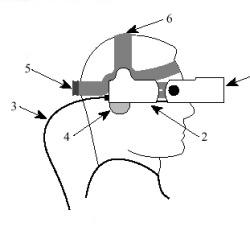
Tom Knoflick
VP - Marketing & Sales of
iReality Company and
subsidiaries VRooMCOM Inc. & General
Reality Company
"There are many reasons why a HMD is not available for the home entertainment market. Several companies including Nintendo, Sega, and Sony have considered the HMD and probably could have produced them at a low enough price point to make them marketable. I believe the main opposition to HMDs in the home involved safety issues (leading to insurance issues), hygienic issues, and concerns about wearing a HMD for a long time period.
"I believe that a simple, easy to wear, HMD or eyeglass will someday be purchased for home use. It may need to be see-through to avoid some of the safety issues, and it definitely needs to be hygienically clean and comfortable to wear. iReality Company, the new name for VRooMCOM Inc. and General Reality Company, fully intends to be a player in this market because of our long history in providing low cost VR solutions to the simulation and game markets, and because of our future vision and direction to provide interactive 3D solutions to the Internet."
Tony Havelka of Tek Gear;
"In my opinion, there isn't an HMD for the home sim market because of a few reasons. First, market risk. Companies such as Sega, Virtual I/O, VictorMaxx, Forte, Phillips and others have tried and not got very far in that market because they did not have a handle on the market. Smaller companies cannot venture into this market as they do not have the resources to produce 100,000's of headset based upon a speculative market.
"The retail culture is not too forgiving for a smaller supplier either. As an example of this lets take a large chain like Fry's Electronics. A customer buys a VR headset and brings it home to play with. It's cool but he starts to get some buyers remorse because it does not look as good as his 15" monitor.
" A week later, after playing with it -non-stop- he brings it back for a full credit. Well, it's no skin off of Fry's nose as they will only pay you for the stuff they sell. Well, if you're on 90 day terms with them, that pounds one stake in the lid of your coffin - delaying this payment further because of returns will pound a few more in.
"VR has been overhyped and under delivered for a long time. The technology that lives up to the hype that was created in the press is just NOW being released in limited quantities. Panel technology just wasn't there until now.
While 180,000 pixel HMDs are cool, they did
not offer the gamer an advantage over using a comparably priced monitor with a
mouse or
joystick. Consumer level HMDs started at $750 and moved to $450
over time. I can get a pretty good 19" CRT monitor for that price. It's
simple economics - price vs. performance.
"Second, lack of title support. While it's neat to play one game with a headset, there has to be universal support for it - just like a mouse. It's too expensive for a specialized peripheral. While some of the HMD manufacturers did make some headway in increasing title support - it was never enough.
"Consumer markets are a killer. The average computer user is sophisticated. They want high performance at an low cost. Consumer HMDs have come close to meeting their requirements. Industrial customers are willing to pay more and put up with deficiencies because they are making money with the HMD.
"The guy at home is spending his hard earned money on it. He is fickle. He demands the best and wants to pay nothing for it. Computer manufacturers have cultivated and ingrained this expectation into everyone. It's tough to create a business model, that works, for this type of market.
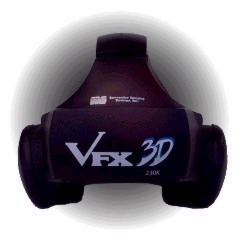
VFX3D
"Third, liability is an issue since there is no control over how long a person can use the HMD. Humans adapt to things very quickly. The suspected root of CyberSickness - a vestibular imbalance, increasingly manifests itself in a user the longer they are immersed."
The imbalance occurs when a user, immersed in a virtual world, is sending mixed signals to their brain. Their eyes are saying they are moving while their inner ear is saying they are not moving. The brain develops a new neural pathway to reprocess the information. This can cause nausea. The effect can be replicated in an IMAX theater or with a monitor in a dark room."
Dave Kanahele
Sales Manager - Display Products
Kaiser Electro Optics
"There have been "low cost" (<$1K) HMDs on the market for a couple of years now, but their performance has been disappointing to say the least. Also, "low cost" is relative. Military HMDs can run well over $100K. Even at $699, HMDs for the consumer market are "expensive" - especially considering the falling prices and quality of monitors these days.
"Then there is the cost of the head tracker and lack of software support. Here at KEO we concentrate on the industrial and military markets. No doubt, however, others are looking at consumer markets considering the multi-billion dollar gaming markets. These include Sony and others. And yes, liability is a significant concern."
What's available?
There are several manufactures of HMDs today. Many are high resolution full immersion HMDs with incredible performance, but at this date all such HMDs are well out of the average PC combat gamers budget.
Interactive Imaging Systems VFX3D
The most promising HMD in development is the is Interactive Imaging Systems VFX3D. The VFX3D has been in the just to be released phase for well over a year and this writer is wondering if the VFX3D will ever be available. Hopefully it will, for it is the only product that even comes close to what would be useful and affordable for the P/C military flight simulation pilot.
"3D Stereoscopic Smart VisorTM
Field of View: 35° Diagonal
Dual 360K pixel
AMLCD
High Contrast, Full Color
Multi-sync capabilities to
Support the following
resolutions:
640X480 60,
62.5, 60, 75 hz (refresh rate)
1024X768 60,
62.5 hz (refresh rate)
Stereo Sound with Built-in Volume Control"
Pitch & Roll Sensitivity:
+/- 70 degrees ~+/- .05 degrees (12 bit)
Yaw Sensitivity:
360 degrees
~+/-.1 degrees (12bit)
Cost? Projected at about $1800 U.S.
N-vision has the most impressive products available as of this time. N-Visions has developed high resolution 3D immersive display systems for use in the commercial, scientific and defense markets. These are definitely the HMDs that PC combat pilots would trade their 21" monitors in for. But it's going to take more than your 21 inch monitor... like the car, the house, the wife or husband ....
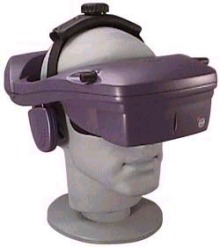
One of n-visions products is the Datavisor LCD. This HMD could become a potential for the PC sim pilot if the resolution were to increase slightly.
- SVGA (640x480)
- Lightweight – Eight Ounces
- 60 degrees field of vision.
Kaiser Electro-Optics, Inc. Head Mounted Displays
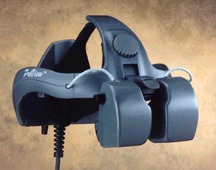
KEO concentrates on the industrial and military markets and has a wide selection of HMDs. Several of KEOs past development product are interesting (awesome might be another word). "As part of ARPA's High Definition Systems Initiative, KEO further developed its patented VIM® technology to two dimensional tiling.
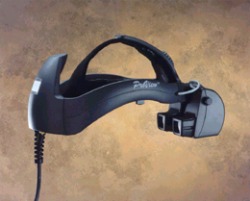
Proview 60
"This provides 6 tiles per eye and achieves 150° horizontal by 50° vertical FOV with 40° of stereo overlap and four-arcminute resolution monochrome or eight-arcminute resolution color. The display sub-system weighs less than two pounds. As part of the program, KEO has designed a true, full-immersion HMD with 15 tiles per eye that provides 180° H x 90° V with 60° stereo overlap and offers less than four-arcminute resolution in the central visual field."
Cost? Don't even think about it!!
Below are some other HMD providers and links to their sites.
Liquid
Image; MRG2.2, MRG3c, MRG4 & X3
i-O Display Systems, i-glasses
General
Reality Companys CyberEyes
OPTICS 1, Inc. HMD's
Can we expect in the near future an HMD that is affordable for the home or mass markets?
Paul Travers of Interactive Imaging
Systems;
"The HMD market has seen difficult times in
the past because the price and technology performance (both in the PC and the
HMD) were not up to the customers requirements and expectations.
"We believe that the winds of change are blowing and that the consumer will see significant new product offerings in this area over the next few years. The PC technology in the areas of software and hardware have accelerated at an incredible pace and the technology required for low cost HMDs is right around the corner.
"The HMD is not really the required device for this market. To have an effective simulation of any kind a great viewing device is only a piece of the puzzle. The viewing device must also be interactive. This allows the user to not only view the cockpit or see into a room, but actually step inside it. Thus creating an Immersive experience very close to being there.
IIS's products offer all these features. We call this new product an Interactive Personal Display or IPD. The bottom line, not just a TV on your face but a completely interactive, stereoscopic HMD with three degree of freedom. Yaw, Pitch and Roll. The next two years are going to bring wonderful advances in this field both in the areas of performance and cost."
Tony Havelka of Tek Gear
"I believe that there is a large enough market out there for a professional HMD and a consumer HMD right now. Only, the technology is just now becoming available to make it happen. Lots of investors got burned in other HMD ventures (Virtual I/O, N-Vision, VictorMaxx, etc...) and their memories are good. It will take a good business plan in order to raise the interest in developing a consumer HMD."
In summary, if the prices are low enough and the performance high enough an incredible mass market for HMD's could be created. And of course this will mean higher performing HMD's and even lower cost, much like 3D video cards have developed. So, when and who will be the first or leading manufacturer in this new potential market? Sony, Interactive Imaging Systems, n-vision, Kaiser Electro-Optics? Or will it be some unheard of start-up company that will catch the present players sleeping? Only time will tell.